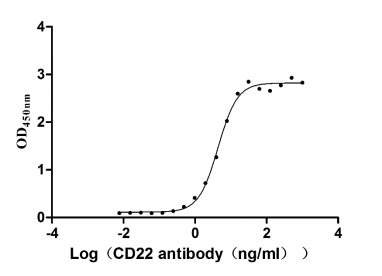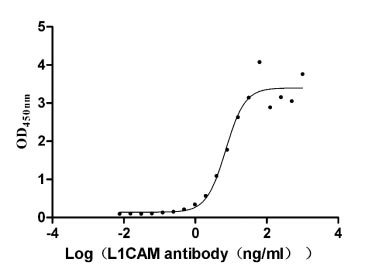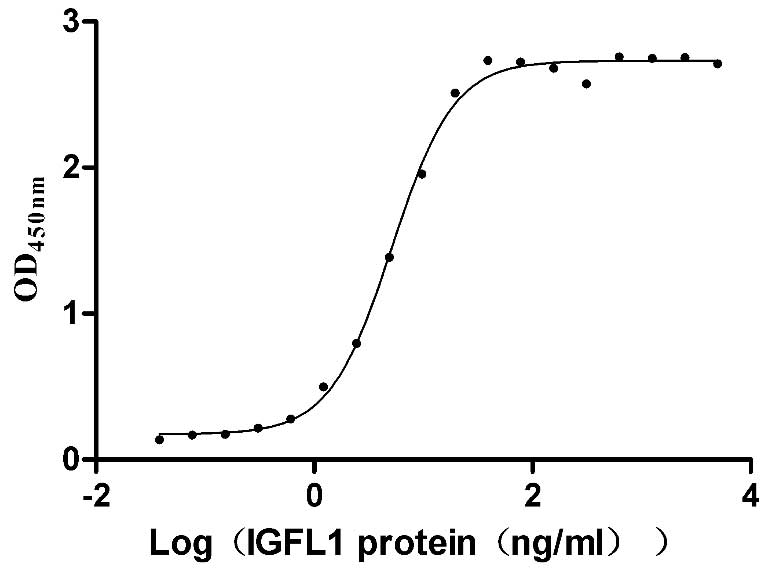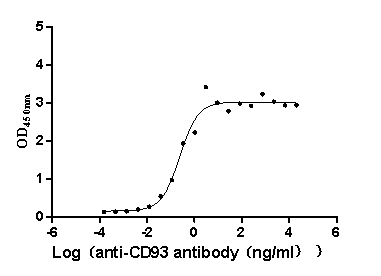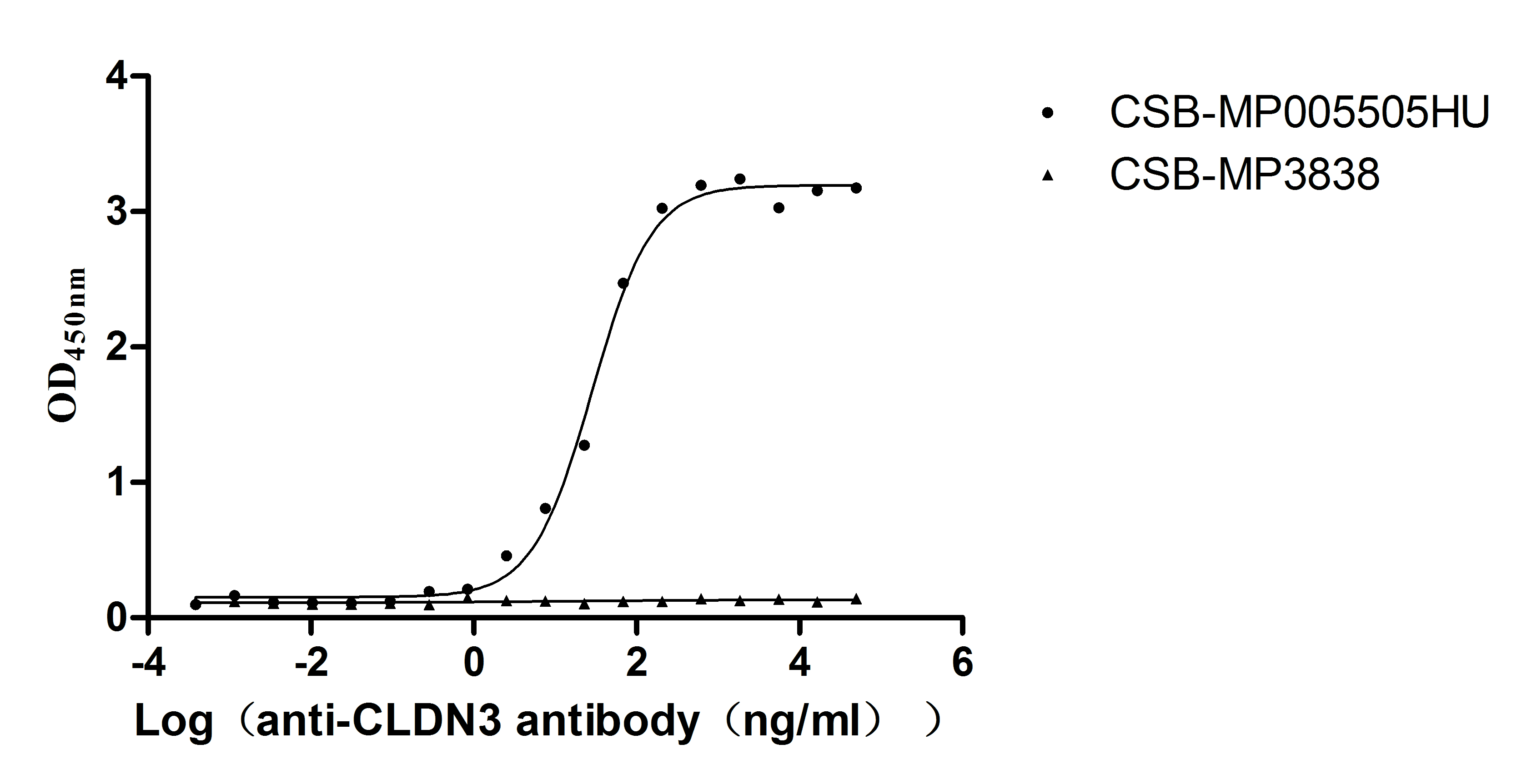Recombinant Mouse Protein-glutamine gamma-glutamyltransferase K (Tgm1), partial
-
中文名稱:小鼠Tgm1重組蛋白
-
貨號:CSB-YP888349MO
-
規(guī)格:
-
來源:Yeast
-
其他:
-
中文名稱:小鼠Tgm1重組蛋白
-
貨號:CSB-EP888349MO
-
規(guī)格:
-
來源:E.coli
-
其他:
-
中文名稱:小鼠Tgm1重組蛋白
-
貨號:CSB-EP888349MO-B
-
規(guī)格:
-
來源:E.coli
-
共軛:Avi-tag Biotinylated
E. coli biotin ligase (BirA) is highly specific in covalently attaching biotin to the 15 amino acid AviTag peptide. This recombinant protein was biotinylated in vivo by AviTag-BirA technology, which method is BriA catalyzes amide linkage between the biotin and the specific lysine of the AviTag.
-
其他:
-
中文名稱:小鼠Tgm1重組蛋白
-
貨號:CSB-BP888349MO
-
規(guī)格:
-
來源:Baculovirus
-
其他:
-
中文名稱:小鼠Tgm1重組蛋白
-
貨號:CSB-MP888349MO
-
規(guī)格:
-
來源:Mammalian cell
-
其他:
產(chǎn)品詳情
-
純度:>85% (SDS-PAGE)
-
基因名:Tgm1
-
Uniprot No.:
-
別名:Tgm1; Protein-glutamine gamma-glutamyltransferase K; EC 2.3.2.13; Epidermal TGase; Transglutaminase K; TG(K); TGK; TGase K; Transglutaminase-1; TGase-1
-
種屬:Mus musculus (Mouse)
-
蛋白長度:Partial
-
蛋白標(biāo)簽:Tag?type?will?be?determined?during?the?manufacturing?process.
The tag type will be determined during production process. If you have specified tag type, please tell us and we will develop the specified tag preferentially. -
產(chǎn)品提供形式:Lyophilized powder
Note: We will preferentially ship the format that we have in stock, however, if you have any special requirement for the format, please remark your requirement when placing the order, we will prepare according to your demand. -
復(fù)溶:We recommend that this vial be briefly centrifuged prior to opening to bring the contents to the bottom. Please reconstitute protein in deionized sterile water to a concentration of 0.1-1.0 mg/mL.We recommend to add 5-50% of glycerol (final concentration) and aliquot for long-term storage at -20℃/-80℃. Our default final concentration of glycerol is 50%. Customers could use it as reference.
-
儲存條件:Store at -20°C/-80°C upon receipt, aliquoting is necessary for mutiple use. Avoid repeated freeze-thaw cycles.
-
保質(zhì)期:The shelf life is related to many factors, storage state, buffer ingredients, storage temperature and the stability of the protein itself.
Generally, the shelf life of liquid form is 6 months at -20°C/-80°C. The shelf life of lyophilized form is 12 months at -20°C/-80°C. -
貨期:Delivery time may differ from different purchasing way or location, please kindly consult your local distributors for specific delivery time.Note: All of our proteins are default shipped with normal blue ice packs, if you request to ship with dry ice, please communicate with us in advance and extra fees will be charged.
-
注意事項:Repeated freezing and thawing is not recommended. Store working aliquots at 4°C for up to one week.
-
Datasheet :Please contact us to get it.
靶點詳情
-
功能:Catalyzes the cross-linking of proteins and the conjugation of polyamines to proteins. Responsible for cross-linking epidermal proteins during formation of the stratum corneum. Involved in cell proliferation.
-
基因功能參考文獻:
- results suggest ADAM17/EGFR-driven PLCgamma1 and PKC pathways as important promoters of TG1 expression during terminal keratinocyte differentiation. PMID: 28004780
- We also reveal that TGM1 modulates lung epithelial junction protein expression, suggesting a potentially protective role for hypoxia-induced TGM1 in pulmonary disease. PMID: 27423780
- Characterization of TGM2 and TGM1-TGM2 double knock-out mouse epidermis showed that unlike TGM2, TGM1 is indispensable for skin formation. PMID: 27864691
- that the up-regulation of molecular signatures for antimicrobial and innate defense responses is characteristic of skin with a transglutaminase 1 deficiency. PMID: 27442430
- Before the appearance of acute renal failure, which is apparent by morphological damage in the kidney and increases in blood creatinine levels, both the expression level and activity of TG1 rapidly increased mainly at the proximal tubule. PMID: 26427353
- This study investigated the in situ activities of transglutaminase-1 (skin-type) and transglutaminase-2 (tissue-type) using whole mouse sections of various embryonic developmental stages and neonates. PMID: 23896968
- The R142C mutation of transglutaminase 1 reduces the enzyme stability which is indispensable for development of the stratum corneum and skin barrier function and for postnatal survival of mice. PMID: 22258055
- Molecular deletion of transglutaminase 2 alone is insufficient to protect Mus musculus neurons from oxidative death, but inhibition of transglutaminase 1 and 2 is neuroprotective. PMID: 22573678
- These studies demonstrate that tranglutaminase 2 independent activity exists in the vasculature and that Tgm1 and tgm4 are expressed in vascular tissues PMID: 22307675
- Mouse models are used to study the role of tissue transglutaminase (tTG)in Huntington's disease; its critical that the level of expression in mouse forebrain be determined. tTG contributes to the majority of transglutaminase activity in mouse forebrain. PMID: 15033177
- Cystamine and cysteamine increase brain levels of BDNF in Huntington disease via HSJ1b and transglutaminase PMID: 16604191
- Tissue-specific stabilization of the cortical actin filament network by intracellular TGase1 activity may play a role in controlling barrier properties of endothelial monolayers PMID: 17337909
- transglutaminase 1 PMID: 17418814
- Transglutaminase induces protofibril-like amyloid beta-protein assemblies that are protease-resistant and inhibit long-term potentiation PMID: 18397883
顯示更多
收起更多
-
亞細胞定位:Membrane; Lipid-anchor.
-
蛋白家族:Transglutaminase superfamily, Transglutaminase family
-
組織特異性:Expressed in large amounts in epithelial tissues (lung, liver and kidney).
-
數(shù)據(jù)庫鏈接:
Most popular with customers
-
Recombinant Human B-cell receptor CD22 (CD22), partial (Active)
Express system: Mammalian cell
Species: Homo sapiens (Human)
-
Recombinant Human Neural cell adhesion molecule L1 (L1CAM), partial (Active)
Express system: Mammalian cell
Species: Homo sapiens (Human)
-
Recombinant Human IGF-like family receptor 1 (IGFLR1), partial (Active)
Express system: Mammalian cell
Species: Homo sapiens (Human)
-
Recombinant Macaca fascicularis CD93 molecule (CD93), partial (Active)
Express system: Mammalian cell
Species: Macaca fascicularis (Crab-eating macaque) (Cynomolgus monkey)
-
Recombinant Human Claudin-3 (CLDN3)-VLPs (Active)
Express system: Mammalian cell
Species: Homo sapiens (Human)
-
Recombinant Human C-C chemokine receptor type 6(CCR6)-VLPs (Active)
Express system: Mammalian cell
Species: Homo sapiens (Human)


